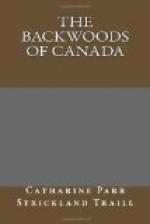This is a barm much used by the Yanky settlers; but though the bread is decidedly whiter, and prettier to look at, than that raised in any other way, the peculiar flavour it imparts to the bread renders it highly disagreeable to some persons. Another disadvantage is, the difficulty of fermenting this barm in the winter season, as it requires a temperature which is very difficult to preserve in a Canadian winter day. Moreover, after the barm has once reached its height, unless immediately made use of, it sinks, and rises again no more: careful people, of course, who know this peculiarity, are on the watch, being aware of the ill consequences of heavy bread, or having no bread but bannocks in the house.
As near as I can recollect, the salt-rising is made as follows:—For a small baking of two or three loaves, or one large bake-kettle-loaf, (about the size of a London peck loaf,) take about a pint of moderately warm water, (a pleasant heat to the hand,) and stir into the jug or pot containing it as much flour as will make a good batter, not too thick; add to this half a tea-spoon of salt, not more, and set the vessel in a pan of moderately warm water, within a little distance of the fire, or in the sun: the water that surrounds the pot in which your rising is, must never be allowed to cool much be low the original heat, more warm water being added (in the pan, not to the barm) till the whole is in an active state of fermentation, which will be from six to eight hours, when the dough must be mixed with it, and as much warm water or milk as you require. Knead the mass till it is tough, and does not stick to the board. Make up your loaf or loaves, and keep them warmly covered near the fire till they rise: they must be baked directly this second rising takes place. Those that bake what I term a shanty loaf, in an iron bake-pot, or kettle, placed on the hot embers, set the dough to rise over a very few embers, or near the hot hearth, keeping the pot or pan turned as the loaf rises; when equally risen all over they put hot ashes beneath and upon the lid, taking care not to let the heat be too fierce at first. As this is the most common method of baking, and the first that a settler sees practised, it is as well they should be made familiar with it beforehand. At first I was inclined to grumble and rebel against the expediency of bake-pans or bake-kettles; but as cooking-stoves, iron ovens, and even brick and clay-built ovens, will not start up at your bidding in the bush, these substitutes are valuable, and perform a number of uses. I have eaten excellent light bread, baked on the emigrant’s hearth in one of these kettles. I have eaten boiled potatoes, baked meats, excellent stews, and good soups, all cooked at different times in this universally useful utensil: so let it not be despised. It is one of those things peculiarly adapted to the circumstances of settlers in the bush before they have collected those comforts about their homesteads, within and without, that are the reward and the slow gleaning-up of many years of toil.




